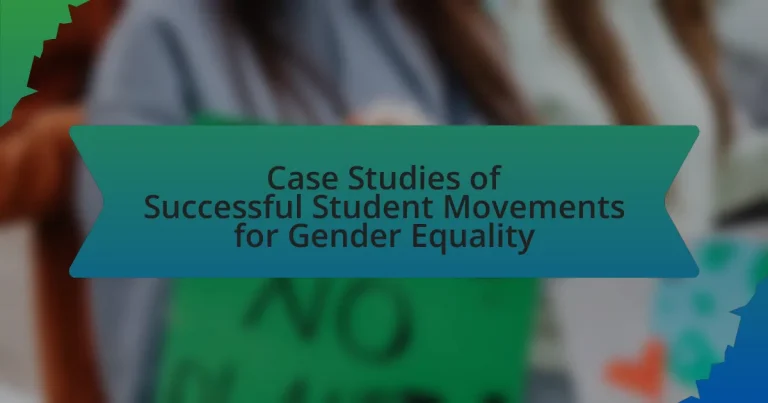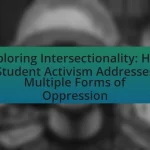Student movements for gender equality are organized efforts by students advocating for equal rights and opportunities across educational institutions and society. This article examines historical and contemporary student movements, highlighting their contributions to gender equality, key events that marked their rise, and the cultural contexts that influence their effectiveness. It also explores notable case studies, strategies employed by these movements, and the role of universities in supporting or hindering their efforts. Additionally, the article discusses the future prospects for student activism in gender equality and practical steps students can take to engage in these movements.
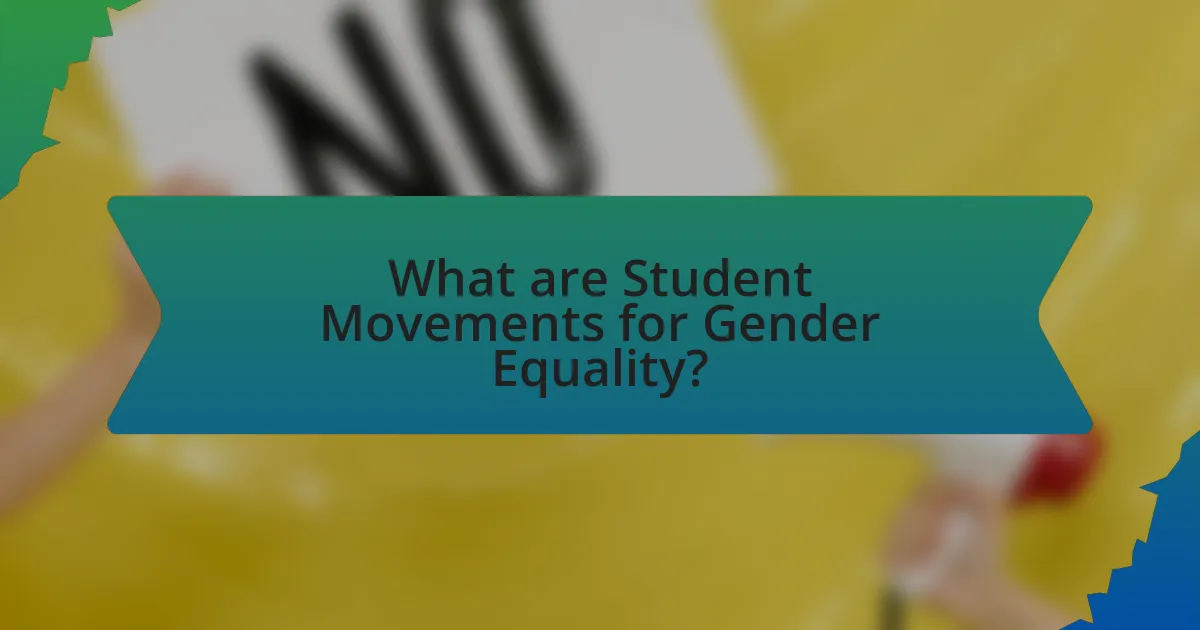
What are Student Movements for Gender Equality?
Student movements for gender equality are organized efforts by students to advocate for equal rights and opportunities regardless of gender within educational institutions and society at large. These movements often focus on issues such as sexual harassment, equal pay, reproductive rights, and representation in leadership roles. Historical examples include the Women’s Liberation Movement of the 1960s and 1970s, which saw significant student involvement, and more recent initiatives like the #MeToo movement, which mobilized students to address sexual violence on campuses. These movements are validated by their ability to influence policy changes, raise awareness, and foster a culture of inclusivity and respect in educational settings.
How have student movements historically contributed to gender equality?
Student movements have historically contributed to gender equality by advocating for women’s rights and challenging discriminatory practices within educational institutions and society at large. For instance, the Women’s Liberation Movement of the 1960s and 1970s saw significant participation from students who organized protests, consciousness-raising groups, and campaigns for equal access to education and reproductive rights. These movements led to policy changes, such as Title IX in the United States, which prohibited sex-based discrimination in federally funded education programs, significantly increasing female enrollment in colleges and universities. Additionally, student-led initiatives have raised awareness about issues like sexual harassment and gender-based violence, fostering a culture of accountability and support for victims.
What key events marked the rise of student movements for gender equality?
Key events that marked the rise of student movements for gender equality include the 1969 Women’s Liberation Movement in the United States, which mobilized students to advocate for equal rights and opportunities. This movement was characterized by protests, consciousness-raising sessions, and the establishment of women’s studies programs in universities. Another significant event was the 1970 International Women’s Day, which saw student-led demonstrations worldwide, emphasizing gender equality and women’s rights. Additionally, the 2017 Women’s March, which included a strong student presence, highlighted issues such as reproductive rights and sexual harassment, further galvanizing student activism for gender equality. These events collectively demonstrate the growing influence and organization of student movements advocating for gender equality across different decades.
How do cultural contexts influence student movements for gender equality?
Cultural contexts significantly influence student movements for gender equality by shaping the values, beliefs, and social norms that students navigate. For instance, in societies with strong patriarchal structures, students may face greater resistance when advocating for gender equality, as seen in countries like Afghanistan, where cultural norms restrict women’s rights. Conversely, in more progressive societies, such as Sweden, students benefit from supportive frameworks that encourage activism, leading to successful movements like the “Girls’ Rights Movement,” which has garnered widespread support and legislative change. These cultural factors dictate not only the challenges faced by student movements but also the strategies employed and the level of community engagement, ultimately affecting the outcomes of their efforts for gender equality.
What are the core objectives of successful student movements for gender equality?
The core objectives of successful student movements for gender equality include advocating for equal rights, raising awareness about gender-based discrimination, and promoting inclusive policies within educational institutions. These movements aim to dismantle systemic barriers that hinder gender equality, such as unequal access to resources and representation. For instance, the 2015 #HeForShe campaign, initiated by UN Women, mobilized students globally to engage in discussions and actions supporting gender equality, demonstrating the effectiveness of collective student advocacy in influencing institutional policies and societal norms.
What specific goals do these movements aim to achieve?
These movements aim to achieve gender equality in educational institutions by advocating for equal rights, representation, and opportunities for all genders. Specifically, they focus on eliminating discriminatory practices, promoting inclusive policies, and raising awareness about gender-based issues within academic environments. For instance, successful student movements have led to the implementation of gender-sensitive curricula and the establishment of support systems for marginalized genders, demonstrating their effectiveness in creating systemic change.
How do these objectives align with broader gender equality initiatives?
The objectives of successful student movements for gender equality align with broader gender equality initiatives by promoting awareness, advocacy, and policy change that support equal rights and opportunities for all genders. These movements often focus on addressing systemic issues such as gender-based violence, discrimination, and unequal access to education, which are also central themes in global gender equality frameworks like the United Nations Sustainable Development Goals (SDGs). For instance, SDG 5 specifically aims to achieve gender equality and empower all women and girls, reflecting the same goals that student movements strive to achieve through grassroots activism and community engagement.
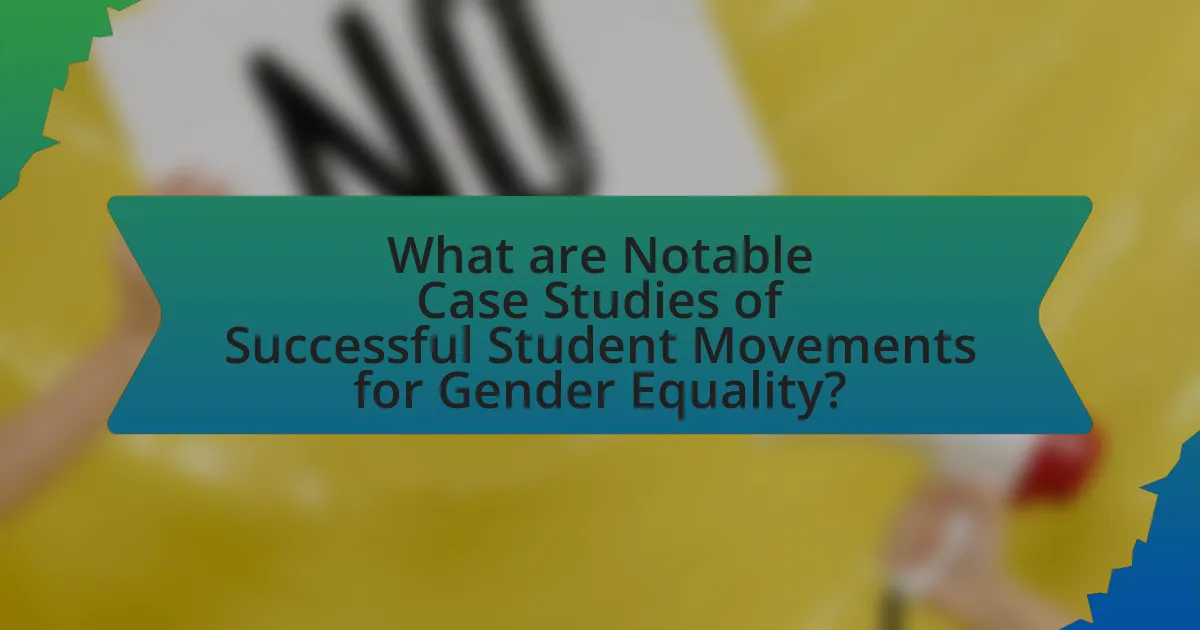
What are Notable Case Studies of Successful Student Movements for Gender Equality?
Notable case studies of successful student movements for gender equality include the “Take Back the Night” campaign and the “HeForShe” initiative. The “Take Back the Night” movement, which began in the 1970s, mobilized students and communities to raise awareness about sexual violence against women, leading to significant policy changes on campuses and increased support services for survivors. The “HeForShe” campaign, launched by UN Women in 2014, engaged students globally to advocate for gender equality, resulting in over 1.2 million commitments from individuals, including students, to promote gender equity. These movements demonstrate the power of student activism in driving societal change and influencing institutional policies regarding gender equality.
Which student movements have made significant impacts globally?
Significant global student movements include the Student Nonviolent Coordinating Committee (SNCC) in the United States, which played a crucial role in the Civil Rights Movement, advocating for racial equality and voter registration among African Americans. Another impactful movement is the 1968 student protests in France, which challenged traditional societal norms and called for educational reforms, influencing global youth activism. Additionally, the #MeToo movement, which gained traction among students and young activists, has raised awareness about sexual harassment and gender equality worldwide. These movements have collectively shaped policies and societal attitudes towards equality and justice, demonstrating the power of student activism in driving change.
What strategies did these movements employ to achieve their goals?
Successful student movements for gender equality employed strategies such as grassroots organizing, coalition-building, and advocacy for policy change. Grassroots organizing involved mobilizing students through rallies, protests, and awareness campaigns to raise consciousness about gender issues. Coalition-building was crucial as these movements often partnered with other organizations, amplifying their voices and resources, which was evident in the collaboration between student groups and local women’s rights organizations. Advocacy for policy change included lobbying university administrations for equitable policies and practices, demonstrated by campaigns that successfully led to the implementation of gender-neutral bathrooms and improved sexual harassment policies on campuses. These strategies collectively contributed to the movements’ effectiveness in achieving their goals.
How did these movements engage with local communities and stakeholders?
These movements engaged with local communities and stakeholders through collaborative initiatives, awareness campaigns, and direct dialogue. For instance, student organizations often partnered with local NGOs to host workshops that educated community members about gender equality issues, thereby fostering a supportive environment. Additionally, they organized public forums that invited stakeholders, including local leaders and educators, to discuss gender-related challenges and solutions, ensuring that diverse perspectives were included in the conversation. This approach not only amplified the voices of marginalized groups but also built a network of allies committed to advancing gender equality within the community.
What lessons can be learned from these successful movements?
Successful movements for gender equality demonstrate the importance of grassroots organization and collective action. These movements often mobilize students to advocate for policy changes, raise awareness, and challenge societal norms. For instance, the #MeToo movement, which gained significant traction among students, highlighted the power of social media in amplifying voices and fostering solidarity. Research indicates that movements with clear goals and inclusive participation tend to achieve greater impact, as seen in the success of the Women’s March, which united diverse groups under a common cause. Additionally, effective communication strategies, such as storytelling and personal testimonies, have proven essential in engaging wider audiences and garnering support.
What challenges did these movements face, and how were they overcome?
Student movements for gender equality faced significant challenges, including institutional resistance, societal stigma, and limited resources. Institutional resistance often manifested as pushback from educational authorities who were reluctant to implement changes, which was overcome through persistent advocacy, coalition-building, and strategic use of media to raise awareness. Societal stigma, which included backlash from conservative groups, was countered by fostering inclusive dialogues and engaging allies to amplify the movements’ messages. Limited resources were addressed by leveraging grassroots fundraising efforts and partnerships with established organizations, allowing movements to sustain their initiatives and campaigns effectively.
How can these lessons be applied to future student movements for gender equality?
Lessons from successful student movements for gender equality can be applied to future initiatives by emphasizing the importance of grassroots organization and coalition-building. For instance, movements like the Women’s March have demonstrated that mobilizing diverse groups around shared goals enhances visibility and impact. Additionally, leveraging social media for awareness and engagement, as seen in the #MeToo movement, allows for rapid dissemination of information and fosters community support. Historical evidence shows that student-led campaigns, such as those at universities advocating for Title IX compliance, effectively utilized strategic partnerships with faculty and administration to achieve policy changes. These approaches highlight the necessity of collaboration, strategic communication, and sustained advocacy in advancing gender equality within educational institutions.
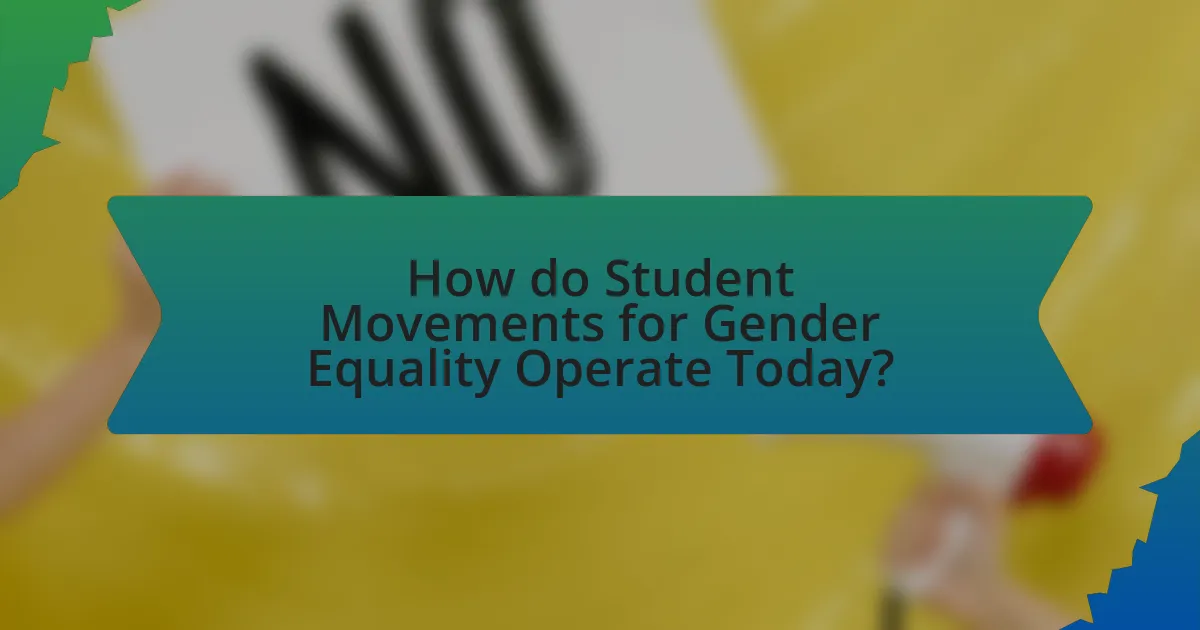
How do Student Movements for Gender Equality Operate Today?
Student movements for gender equality today operate through organized advocacy, digital activism, and coalition-building. These movements utilize social media platforms to raise awareness, mobilize supporters, and disseminate information rapidly, exemplified by campaigns like #MeToo and #TimesUp, which gained global traction among students and young activists. Furthermore, they often collaborate with established organizations, such as the United Nations and local NGOs, to amplify their impact and access resources. Research indicates that student-led initiatives have successfully influenced policy changes in educational institutions, such as implementing gender-sensitive curricula and establishing support systems for survivors of gender-based violence. This collaborative and multifaceted approach enables student movements to effectively challenge systemic inequalities and promote gender equity in various contexts.
What modern tools and platforms are used by student movements?
Student movements utilize various modern tools and platforms, including social media, messaging apps, and online petition sites. Social media platforms like Twitter, Instagram, and Facebook enable rapid information dissemination and mobilization of supporters, as evidenced by movements such as #MeToo and #BlackLivesMatter, which gained traction through these channels. Messaging apps like WhatsApp and Telegram facilitate secure communication and coordination among activists, allowing for real-time updates and planning. Additionally, online petition platforms like Change.org empower students to gather support for their causes, exemplified by petitions that have successfully influenced policy changes in educational institutions. These tools collectively enhance the visibility, organization, and impact of student movements advocating for gender equality.
How has social media changed the landscape of student activism?
Social media has significantly transformed student activism by providing a platform for rapid communication, mobilization, and awareness-raising. This shift allows students to organize protests, share information, and connect with like-minded individuals across geographical boundaries, enhancing the reach and impact of their movements. For instance, the #MeToo movement gained momentum through social media, enabling students to share their experiences and advocate for gender equality on a global scale. Research indicates that social media platforms can amplify voices that might otherwise be marginalized, facilitating a more inclusive dialogue around issues of gender equality in educational settings.
What role do universities play in supporting or hindering these movements?
Universities play a significant role in both supporting and hindering student movements for gender equality. They can support these movements by providing platforms for dialogue, resources for activism, and institutional backing for initiatives aimed at promoting gender equality. For instance, many universities have established gender studies programs and support services that empower students to advocate for their rights and engage in activism. Conversely, universities can hinder these movements through policies that restrict free speech, limit student organizing, or fail to address issues of gender discrimination effectively. A notable example is the backlash against student-led protests at some institutions, where administrations have imposed disciplinary actions against activists, thereby stifling their efforts. This dual role illustrates how universities can either facilitate or obstruct progress toward gender equality, depending on their policies and institutional culture.
What are the future prospects for student movements advocating for gender equality?
The future prospects for student movements advocating for gender equality are promising, as these movements continue to gain momentum and visibility. Increasing global awareness of gender issues, supported by social media platforms, allows student activists to mobilize quickly and effectively, reaching wider audiences. For instance, the #MeToo movement, which originated from grassroots activism, has inspired numerous student-led initiatives worldwide, demonstrating the potential for sustained impact. Additionally, educational institutions are increasingly recognizing the importance of gender equality, leading to more supportive environments for student activism. This trend is evidenced by the establishment of gender studies programs and policies aimed at promoting inclusivity on campuses. As a result, student movements are likely to evolve into more organized and influential forces in advocating for gender equality in the coming years.
How can student movements adapt to changing societal norms and challenges?
Student movements can adapt to changing societal norms and challenges by employing flexible strategies that incorporate digital platforms, grassroots organizing, and intersectional approaches. For instance, the #MeToo movement, which gained momentum through social media, illustrates how student-led initiatives can leverage technology to raise awareness and mobilize support for gender equality. Additionally, student movements can engage in coalitions with other social justice groups to address overlapping issues, thereby broadening their impact and relevance. Historical examples, such as the 1960s civil rights movement, demonstrate that adaptability in messaging and tactics is crucial for sustaining momentum and achieving goals in the face of evolving societal landscapes.
What strategies can enhance the effectiveness of future movements?
To enhance the effectiveness of future movements, strategies such as building coalitions, leveraging social media, and focusing on clear messaging are essential. Building coalitions allows diverse groups to unite, increasing resources and influence, as seen in the Women’s March, which mobilized millions globally through collaboration. Leveraging social media enables rapid dissemination of information and engagement, exemplified by the #MeToo movement, which gained traction through online platforms, amplifying voices and experiences. Focusing on clear messaging ensures that the movement’s goals are easily understood and relatable, as demonstrated by the March for Our Lives, which effectively communicated its stance on gun control to resonate with a broad audience. These strategies collectively contribute to the mobilization and impact of movements advocating for gender equality.
What practical steps can students take to initiate or join movements for gender equality?
Students can initiate or join movements for gender equality by forming or participating in campus organizations focused on advocacy, awareness, and education. These organizations can host events, workshops, and discussions that promote gender equality and engage the student body. For instance, the establishment of groups like “Women in Leadership” or “Gender Equality Now” on campuses has proven effective in mobilizing students and raising awareness about gender issues. Additionally, students can collaborate with existing organizations such as the United Nations Women or local NGOs to amplify their efforts. Research indicates that student-led initiatives can significantly influence policy changes and campus culture, as seen in the 2018 “March for Our Lives” movement, which highlighted the power of youth activism in driving social change.
